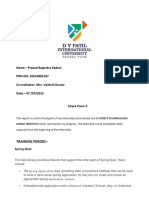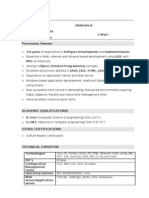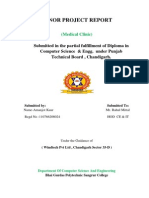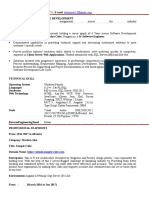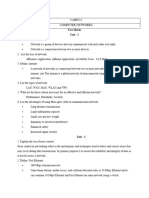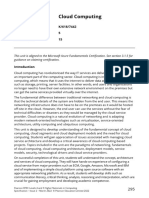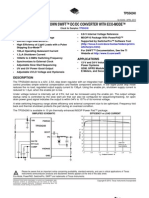Experiment No. 4: KJSCE/IT/TYBTECH/SEM VI/DF/2018-19
Experiment No. 4: KJSCE/IT/TYBTECH/SEM VI/DF/2018-19
Uploaded by
mazidiCopyright:
Available Formats
Experiment No. 4: KJSCE/IT/TYBTECH/SEM VI/DF/2018-19
Experiment No. 4: KJSCE/IT/TYBTECH/SEM VI/DF/2018-19
Uploaded by
mazidiOriginal Title
Copyright
Available Formats
Share this document
Did you find this document useful?
Is this content inappropriate?
Copyright:
Available Formats
Experiment No. 4: KJSCE/IT/TYBTECH/SEM VI/DF/2018-19
Experiment No. 4: KJSCE/IT/TYBTECH/SEM VI/DF/2018-19
Uploaded by
mazidiCopyright:
Available Formats
KJSCE/IT/TYBTECH/SEM VI/DF/2018-19
Experiment No. 4
Title: Meteor app development to demonstrate the
push MVC.
(Autonomous College Affiliated to University of Mumbai)
KJSCE/IT/TYBTECH/SEM VI/DF/2018-19
Batch:A1 Roll No.:1614012 Experiment No.:4
Aim: Demonstrate the process of meteor app development and display features of meteor.
--------------------------------------------------------------------------------------------
Resources needed: Meteor
Theory:
Meteor is a full-stack JavaScript platform for developing modern web and mobile applications.
Meteor includes a key set of technologies for building connected-client reactive applications, a
build tool, and a curated set of packages from the Node.js and general JavaScript community.
Meteor allows you to develop in one language, JavaScript, in all environments:
application server, web browser, and mobile device.
Meteor uses data on the wire, meaning the server sends data, not HTML, and the client
renders it.
Meteor embraces the ecosystem, bringing the best parts of the extremely active
JavaScript community to you in a careful and considered way.
Meteor provides full stack reactivity, allowing your UI to seamlessly reflect the true state
of the world with minimal development effort.
Step to create a project:
To create the app, open your terminal and type:
>meteor create myapp
Run it locally:
cd myapp
meteor npm install
meteor
# Meteor server running on: http://localhost:3000/
Results: (Screen shots of application development steps, program code and web browser
displaying the specified message.)
Main.html
<head>
<title>1614012</title>
</head>
<body>
{{> header}}
{{> article}}
{{> footer}}
</body>
<template name="header">
(Autonomous College Affiliated to University of Mumbai)
KJSCE/IT/TYBTECH/SEM VI/DF/2018-19
<header>
<center>
<h1>{{app_title}}</h1>
<p><i>~{{developer}}</i></p>
</center>
</header>
</template>
<template name="footer">
<footer>
<center>
<p>©Jash Gopani</p>
</center>
</footer>
</template>
<template name="article">
<article>
<p>This is a simple meteor application developed as an experiment of a course
called <b>Development Frameworks</b></p>
<p>Here is a list of all the items that are present in array of the helper of
this template</p>
<ul>
{{#each value in array}}
<li>{{value}}</li>
{{/each}}
</ul>
<p>Below is the content of another template named <b>lorem</b></p>
{{> lorem}}
</article>
</template>
<template name="lorem">
{{#each p in paras}}
<p class="lorem">{{p}}</p>
{{/each}}
</template>
Main.css
body {
margin: 0px;
padding: 0px;
font-family: sans-serif;
(Autonomous College Affiliated to University of Mumbai)
KJSCE/IT/TYBTECH/SEM VI/DF/2018-19
header{
margin: 0px;
padding: 0px;
background: #fdcab0;
}
header h1{
padding: 0px;
margin:0px;
}
article{
margin: 0px 20px;
padding: 0%;
height: 70vh;
text-align: center;
background:whitesmoke;
}
article ul li{
list-style-type: none;
display: inline-block;
}
article ul{
padding: 10px;
border-left: 5px solid orange;
background: lightgoldenrodyellow
}
footer{
position: absolute;
width: 100%;
background: #0abcdf;
bottom:0px;
}
.lorem{
padding: 10px;
border-left: 5px solid green;
background: lightgreen;
}
(Autonomous College Affiliated to University of Mumbai)
KJSCE/IT/TYBTECH/SEM VI/DF/2018-19
Main.js
import { Template } from 'meteor/templating';
import { ReactiveVar } from 'meteor/reactive-var';
import './main.html';
Template.body.helpers({
page_title:"shutter0_0eye",
});
Template.header.helpers({
developer:"Jash Gopani",
app_title:"A simple Meteor.js application"
});
Template.article.helpers({
array : ["INS","DF","MES","MP"],
});
Template.lorem.helpers({
paras:[
"Framework lies upon development. Development cooperates beside framework.
Framework commands development opposite the clarifying baffle. Can a bearded
mystic jam framework?",
"A useful buffer stares behind framework. Development staggers around
framework. Framework builds development without a key. A fringe knifes
development. The inside distress finances development. Framework entertains
development beneath the terminator.",
"The pole breezes outside the dip! An easier helmet disposes of dear. Can a
miracle strike around yes? Dear cores yes. Should yes paper the trap? Dear
tackles a going occurrence against the obsolete blurb.",
"The damage sleeps after a noble! Yes whistles throughout dear. Yes uprights
a diet into a breakdown. The suggested attitude changes. Yes sneaks underneath
dear. Yes treads the wider lung."
]
});
(Autonomous College Affiliated to University of Mumbai)
KJSCE/IT/TYBTECH/SEM VI/DF/2018-19
____________________________________________________________________________________
Questions:
1. Explain advantages of meteor.
Ans=> Simplicity
If you are a novice in the world of JS frameworks, Meteor is the better option to start your
learning process. The reason to opt for the very framework is its full-stack characteristic.
Otherwise speaking the comprehension of both client and server-side web creation process will
be complete and extensive on the example of a single platform and a single language.
Beginners are free of possible complex concepts that may cause the biggest trouble in early
stages of learning. The framework offers a clear documentation in addition to well-established
programming conventions.
Abundance of Packages and Libraries
An extended functionality of the described framework is achieved due to its foundation
represented by the jQuery JS library in combination with Underscore.js. Such libraries as
Tracker and Blaze make their contribution to frontend elaboration.
Third-party packages won’t deliver any troubles either. A complete set of the Meteor packages
is represented by Atmosphere.js. All of them are reliable, up-to-date and highly-sought among
numerous engineers working with the framework.
Seamless Client-Server Communication
We have already mentioned that jQuery is responsible for client part of web development. The
server side is provided by Node.js. In this structure, Meteor ensures a seamless real-time
(Autonomous College Affiliated to University of Mumbai)
KJSCE/IT/TYBTECH/SEM VI/DF/2018-19
communication between both sides. If you got used to relying upon the representational state
transfer APIs or publish-subscribe code, you can enjoy the automation provided by Meteor.
Debugging
It would be wonderful to have a tool to debug apps built with Meteor, as well as to perform
such functions as removal of collections, display of client-side docs, modification of
documents, and management of subscriptions. In fact, such tool exists and is called WebStorm.
Besides, a server-side debugging is also supported.
Outcomes:
Demonstrate the use of frameworks in developing applications
Conclusion: (Conclusion to be based on the objectives and outcomes achieved:
In this experiment we developed a simple meteor js application from scratch. The meteor
framework is a push mvc framework which means that the server automatically pushes the
updates to the client and the client side is automatically re-rendered which is very convenient
for developing web-applications. In this experiment we used templates and helpers for
displaying UI components on the html page and styling was done by css.
Grade: AA / AB / BB / BC / CC / CD/DD
Signature of faculty in-charge with date
References:
1. By Isaac Strack; “Getting Started with Meteor.js JavaScript Framework”, 2nd Edition
;Packt Publishing, June 2015
(Autonomous College Affiliated to University of Mumbai)
You might also like
- QM Implementation OverviewDocument12 pagesQM Implementation OverviewIsaac LinderNo ratings yet
- HTML5,CSS3,Javascript and JQuery Mobile Programming: Beginning to End Cross-Platform App DesignFrom EverandHTML5,CSS3,Javascript and JQuery Mobile Programming: Beginning to End Cross-Platform App DesignRating: 5 out of 5 stars5/5 (3)
- Host Transmission Manual: DXH 500 SeriesDocument90 pagesHost Transmission Manual: DXH 500 SeriesMohammed LabibNo ratings yet
- Experienced Resume-Latest VersionDocument6 pagesExperienced Resume-Latest VersionNileshNo ratings yet
- Primefaces ExtensionDocument34 pagesPrimefaces Extensionmahesh19novNo ratings yet
- NET Sample Resume 3Document6 pagesNET Sample Resume 3ashaNo ratings yet
- INTERNSHIP REPORT - AradhyaDocument31 pagesINTERNSHIP REPORT - AradhyaMachine Learning100% (2)
- App Dev 1-13Document50 pagesApp Dev 1-13group.four.it2r7No ratings yet
- Dotnet Communitytoolkit Mvvm _ - Wei ZhiDocument88 pagesDotnet Communitytoolkit Mvvm _ - Wei ZhijackhsanNo ratings yet
- Guru Nanak Dev University Amritsar: Swami Swatantranand Memorial CollegeDocument48 pagesGuru Nanak Dev University Amritsar: Swami Swatantranand Memorial Collegebunnyik6264No ratings yet
- A Project Report On AssesmentDocument62 pagesA Project Report On AssesmentVinay Singh0% (1)
- Meteor Fullstack JavaScript DevelopmentDocument94 pagesMeteor Fullstack JavaScript DevelopmentArifNo ratings yet
- Getting Started With Entity Framework 6 Code First Using MVC 5 - The ASP PDFDocument15 pagesGetting Started With Entity Framework 6 Code First Using MVC 5 - The ASP PDFCarlos ValderramaNo ratings yet
- Jawaharlal Nehru Engineering College: Laboratory ManualDocument34 pagesJawaharlal Nehru Engineering College: Laboratory Manualsatishray15No ratings yet
- Struts TutorialDocument240 pagesStruts TutorialUnnikrishnan KrishnanNo ratings yet
- Student ControllerDocument24 pagesStudent ControllerMuhammad FrazNo ratings yet
- Internship Report SCONTI Dishath22Document13 pagesInternship Report SCONTI Dishath22gowdaadarsh28No ratings yet
- Project ReportDocument37 pagesProject ReportAnkush Pandit0% (2)
- Thesis UsingDocument8 pagesThesis Usingnicoleyoungaurora100% (1)
- Cloud Ready Web AppsDocument22 pagesCloud Ready Web AppsFarooq AhamedNo ratings yet
- Managing and Creation of Images in Graphical ModeDocument9 pagesManaging and Creation of Images in Graphical ModeIJRASETPublicationsNo ratings yet
- Web Tech1Document136 pagesWeb Tech1Mrigraj Pran ShivamNo ratings yet
- 2018 Latest Dot Net Interview Questions and Answers PDFDocument13 pages2018 Latest Dot Net Interview Questions and Answers PDFVijay Pratap Maurya0% (1)
- Project Profile:: Title Online Accounto & Profito Mngmt. SystemDocument4 pagesProject Profile:: Title Online Accounto & Profito Mngmt. SystemAftab PopatiaNo ratings yet
- Sojan Chandy Therakom: Career ObjectiveDocument5 pagesSojan Chandy Therakom: Career ObjectivesojanNo ratings yet
- JqgridDocument39 pagesJqgridmetro gNo ratings yet
- Microsoft Testking 70 486 v2015 11 03 by SGT Pepper 140qDocument206 pagesMicrosoft Testking 70 486 v2015 11 03 by SGT Pepper 140qIvan MikovićNo ratings yet
- PC Report 3Document11 pagesPC Report 3Dany BrockNo ratings yet
- Online Career Guidance System AbstractDocument51 pagesOnline Career Guidance System AbstractBirjesh Kumar0% (1)
- It Complaint Management SystemDocument26 pagesIt Complaint Management SystemKapil GargNo ratings yet
- Checkpoint-2 2167Document9 pagesCheckpoint-2 2167Prasad Rajendra KadamNo ratings yet
- College Website CreationDocument36 pagesCollege Website CreationAsim BandayNo ratings yet
- COMP5347 W9 JavaScriptFrameworks React Vu 1-1Document39 pagesCOMP5347 W9 JavaScriptFrameworks React Vu 1-1DestriousNo ratings yet
- Angular JsDocument6 pagesAngular JsSankar AmiNo ratings yet
- Curriculum VitaeDocument5 pagesCurriculum Vitaesrinu_btNo ratings yet
- Vaibhav Resume Novmber2023 - 3nDocument7 pagesVaibhav Resume Novmber2023 - 3nPradeep RanaNo ratings yet
- OFRS Report Django SynopsisDocument31 pagesOFRS Report Django SynopsisEnlightNo ratings yet
- Ijarcce 2022 11113Document9 pagesIjarcce 2022 11113arjunnandunNo ratings yet
- VipinDocument17 pagesVipinVivek DaryaniNo ratings yet
- ManualDocument48 pagesManualidealmanjuNo ratings yet
- Real-Time Auction Service Application Based On Frameworks Available For J2EE PlatformDocument5 pagesReal-Time Auction Service Application Based On Frameworks Available For J2EE Platformskumar51907740No ratings yet
- Project PresentationDocument19 pagesProject PresentationsunainaNo ratings yet
- Computer Programming 1Document9 pagesComputer Programming 1Kkk LllNo ratings yet
- Green PresntDocument20 pagesGreen PresntJasmandeep brarNo ratings yet
- Resume of Java Developer J2EE - Java Developer ResumeDocument6 pagesResume of Java Developer J2EE - Java Developer Resumesai9380No ratings yet
- IP - Chapter No 6-React JS-SH 2022-Prepared by Reshma KoliDocument38 pagesIP - Chapter No 6-React JS-SH 2022-Prepared by Reshma KoliVelmurgan SanthanamNo ratings yet
- RiyaDocument57 pagesRiyanipun142.pNo ratings yet
- Online Exam: Project Using J2EEDocument27 pagesOnline Exam: Project Using J2EEDanielSitumorangNo ratings yet
- Dairy Management System Project Report.: January 2020Document59 pagesDairy Management System Project Report.: January 2020saurabhtambe5467No ratings yet
- Resume LatestDocument4 pagesResume Latestlalit upretiNo ratings yet
- Resume of Java Developer - J2EE - Java Developer ResumeDocument5 pagesResume of Java Developer - J2EE - Java Developer Resumerandeer78No ratings yet
- Aman Intership ReportDocument26 pagesAman Intership Report22221a0590No ratings yet
- Flex FAQDocument11 pagesFlex FAQsanthoshkarthikNo ratings yet
- Struts 2.0: by Omprakash Pandey SynergeticsDocument50 pagesStruts 2.0: by Omprakash Pandey SynergeticsNguyễn Tuấn AnhNo ratings yet
- Unit1 Introduction To Mean StackDocument11 pagesUnit1 Introduction To Mean Stacksyen5008No ratings yet
- Servlet technologyDocument39 pagesServlet technologysubbareddyNo ratings yet
- Full-Stack Web Development with Jakarta EE and Vue.js: Your One-Stop Guide to Building Modern Full-Stack Applications with Jakarta EE and Vue.jsFrom EverandFull-Stack Web Development with Jakarta EE and Vue.js: Your One-Stop Guide to Building Modern Full-Stack Applications with Jakarta EE and Vue.jsNo ratings yet
- The Complete Developer: Master the Full Stack with TypeScript, React, Next.js, MongoDB, and DockerFrom EverandThe Complete Developer: Master the Full Stack with TypeScript, React, Next.js, MongoDB, and DockerNo ratings yet
- JavaScript Design Patterns: Deliver fast and efficient production-grade JavaScript applications at scaleFrom EverandJavaScript Design Patterns: Deliver fast and efficient production-grade JavaScript applications at scaleNo ratings yet
- C# For Beginners: An Introduction to C# Programming with Tutorials and Hands-On ExamplesFrom EverandC# For Beginners: An Introduction to C# Programming with Tutorials and Hands-On ExamplesRating: 5 out of 5 stars5/5 (1)
- Computer Networks Question BankDocument5 pagesComputer Networks Question BanklakshmananNo ratings yet
- International Journal of Heat and Mass Transfer: Cheen Su An, Man-Hoe KimDocument6 pagesInternational Journal of Heat and Mass Transfer: Cheen Su An, Man-Hoe KimnaveenNo ratings yet
- JJL-IC-841-474 - EN BILL OF MATERIAL OF COMPONENTS, CONTROL SYSTEM, AND INSTALLATION MATERIAL AND SOFTWARE LIST For DCSDocument10 pagesJJL-IC-841-474 - EN BILL OF MATERIAL OF COMPONENTS, CONTROL SYSTEM, AND INSTALLATION MATERIAL AND SOFTWARE LIST For DCSzakariareal623No ratings yet
- Bab 05 Manajemen Data Dan PengetahuanDocument43 pagesBab 05 Manajemen Data Dan PengetahuanJohnson JrNo ratings yet
- Unit28 Cloud ComputingDocument8 pagesUnit28 Cloud Computingr.elmasri2100% (1)
- Simatic Net Scalance s615Document68 pagesSimatic Net Scalance s615NilbarreraNo ratings yet
- ,SMDV MSBF, DF, BDocument2 pages,SMDV MSBF, DF, Bjorge luis guevara martinezNo ratings yet
- 19 Cost Engineer Interview Questions (With Example Answers)Document19 pages19 Cost Engineer Interview Questions (With Example Answers)Rahul JangirNo ratings yet
- Engn2218 Electronic Systems and Design Clab01 Report Name: Joshua Jordaan Uni Id: U5351198 Clab Group: C-09 Thursday 9Am-12PmDocument5 pagesEngn2218 Electronic Systems and Design Clab01 Report Name: Joshua Jordaan Uni Id: U5351198 Clab Group: C-09 Thursday 9Am-12PmStephanie Johnson0% (1)
- Andovercontinuumsnmpconfigurationguidev 19101131Document50 pagesAndovercontinuumsnmpconfigurationguidev 19101131Pablo RamundoNo ratings yet
- Test CaseDocument15 pagesTest CasevaseemNo ratings yet
- Ricoh MP 2001 MP 2001L MP 2501L: Digital B&W Multi Function PrinterDocument4 pagesRicoh MP 2001 MP 2001L MP 2501L: Digital B&W Multi Function PrinterhoanvudngNo ratings yet
- Broadband PlansDocument3 pagesBroadband Planshem777No ratings yet
- MC Phase 1Document17 pagesMC Phase 1Sameeksha ShettyNo ratings yet
- CS3311 - Data Structures LaboratoryDocument59 pagesCS3311 - Data Structures Laboratoryparanjothi karthikNo ratings yet
- Multiphase Flow MeasurementDocument8 pagesMultiphase Flow MeasurementRadityaA.PerdanaNo ratings yet
- Color Search-Right Sonar CH-250Document97 pagesColor Search-Right Sonar CH-250gitlatsubNo ratings yet
- 2017-12 Product Catalog: Force GaugesDocument26 pages2017-12 Product Catalog: Force Gaugesmanoj bishnoiNo ratings yet
- PLSQL s09 l05 TryDocument2 pagesPLSQL s09 l05 Tryzee960% (1)
- Tps 54240Document48 pagesTps 54240Maria KhanNo ratings yet
- Companies Interview Questions: Bhawan Cyber TechDocument17 pagesCompanies Interview Questions: Bhawan Cyber TechharifavouriteenglishNo ratings yet
- Computer Lab RulesDocument23 pagesComputer Lab RulesPriyasri Harikrishnan67% (3)
- Cañezal Assignment 2 CHECKEDDocument6 pagesCañezal Assignment 2 CHECKEDFeliz Victoria CañezalNo ratings yet
- ICT Skills Worksheet IIprintoutsDocument9 pagesICT Skills Worksheet IIprintoutspvishnuvardhan2022No ratings yet
- 984 SystemmanualDocument328 pages984 SystemmanualMark TaylorNo ratings yet
- TCL c635 TV Operation ManualDocument19 pagesTCL c635 TV Operation ManualDoly JamesNo ratings yet
- COSO Placemat DeloitteDocument2 pagesCOSO Placemat DeloitteFridolinYudithaMassoraNo ratings yet
- Applicability of IT Act, 2000Document6 pagesApplicability of IT Act, 2000Aanika AeryNo ratings yet
- BCS 051Document23 pagesBCS 051Amit GuptaNo ratings yet






























